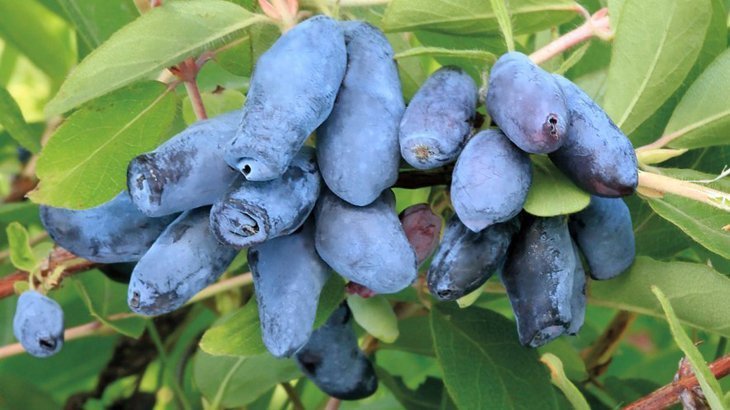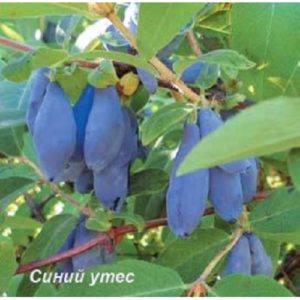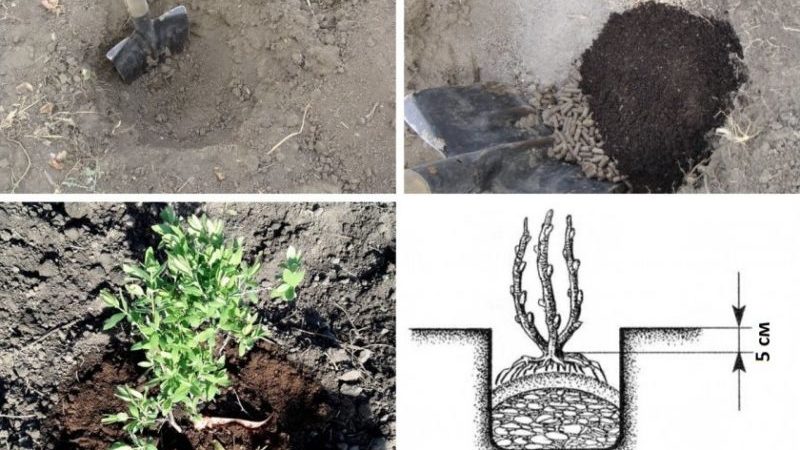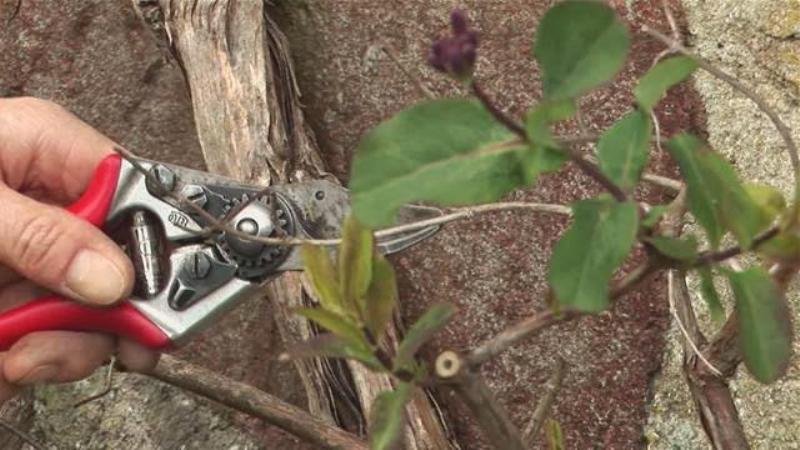Early ripe honeysuckle variety "Blue Cliff"
Honeysuckle is a culture genetically adapted to harsh climatic conditions. Therefore, it is widespread in regions where spring frosts, severe frosts and hot days are frequent. On the basis of wild species of shrubs, breeders have created many varieties that bear fruit with sweet berries. The blue cliff is one of the most popular.
The content of the article
Description of Blue Cliff Honeysuckle
Blue Cliff is a new variety that meets all the needs of gardeners from regions with cold and changeable climates. Honeysuckle it is distinguished by the large size of sweet fruits and excellent frost resistance. The bushes are low-growing, medium-spreading, with straight green shoots, on which there are medium-sized elongated oval-shaped leaves.

Origin
The variety was bred at the Bakchar OPSS, in the village of Bakchar, Tomsk region. Authors Savinkova N.V. and Gagarkin A.V. in 1987 conducted free pollination of the selected form of Kamchatka honeysuckle 2-64-32. During this period, a team of scientists was collecting a collection of wild-growing berries, the study of which was supposed to help the emergence of new promising crops with increased consumer qualities.
Specifications
The variety has a standard bush of a raised rounded shape, which gives a great advantage for mechanized harvesting. The berries are clearly visible, since the foliage is small.
Fruits are large, dark purple, with a strong waxy bloom and slightly hilly surface. Elongated oval shape. Weight - from 2 to 2.6 g, average number of seeds. The tasting committee gave the fresh berries a rating of 4.9 out of 5 possible points. The peel of the fruit is of medium thickness, the taste is sweet and sour, pleasant, the aroma is moderate.
Composition per 100 g:
- dry soluble substances - 14.7%;
- sugar - 9.8%;
- acids - 3.1%;
- vitamin C - 42.3 mg.
Application features
Blue Rock is a versatile variety suitable for both fresh consumption and harvesting. Jams and compotes, which are distinguished by a delicate aroma and rich color, are especially tasty. Berries are well stored, mashed with sugar, suitable for freezing.
Productivity and fruiting
Honeysuckle is characterized by amicable ripening of fruits, which are practically (up to 90%) the same in size and weight. The average yield of the bush is reached by 3-4 years and is 3.5-4 kg of berries that are not prone to shedding.
Reference. The greatest value of the volume of the crop reaches 7-8 years of the plant, when it is in its prime.
Fruiting is annual, without interruption, abundant, lasts up to 15 years of culture life. At the time of the ripening of the harvest, the branches are hung with purple-blue clusters, clearly visible on the branches.
Ripening period
The first ripe berries appear in early July. Mass ripening usually occurs in the middle of the month. Due to weather conditions, the dates are shifted by several days, therefore, in cloudy and cool summers, harvesting is carried out later.
Disease and pest resistance
It was previously believed that the shrub is not exposed to neither disease nor insect attacks, but with the spread of honeysuckle in different regions of the country, it became clear that the crop must be protected from pests and infections.
With improper care, plants are threatened:
- ramulariasis is a consequence of the activity of fungi, leading to the weakening of the plant;
- cercosporosis - infection with fungi, leading to the drying out of the bush;
- tuberculariosis - wilting and subsequent death of leaves and shoots;
- powdery mildew - deformation and dying off of shoots and foliage, which leads to infection with a fungus;
- rash mosaic virus is a disease spread by nematodes.
Pest insects and their larvae weaken bushes by sucking juices from young shoots and leaves. Mass attacks of pests lead to loss of crops and even death of the weakest plants.
Most often appear on the bushes:
- rose leaf roll - a fluffy caterpillar braiding young sprouts with cobwebs;
- fingerfly honeysuckle - a butterfly eating the ovary, destroying not only the pulp of future berries, but also the seeds;
- aphid - small insects, without prevention and control, can appear in two generations per season;
- gooseberry moth - a gluttonous caterpillar that eats young growth;
- willow and acacia scale insects - insects that suck the juices from the shoots.
Cold and drought resistant
Blue Cliff is a frost resistant variety. During the tests, the shrub tolerated winter air temperature drops to -49 ... -50.6 ° C. Even during the flowering period, the culture is very resistant to cold, flowers are tolerated without negative consequences of freezing to -7 ... -8 ° С.
Drought resistance is average. Good watering is required during the period of active growth and fruiting.
Demanding climate
Hot and arid regions are not suitable for growing Blue Cliff: there the shrub grows reluctantly, develops slowly, bears fruit poorly. Attempts to adapt honeysuckle to growing in the southern regions did not lead to the desired result - genetically inherent frost resistance forces the plant to develop better and bear fruit abundantly in regions with a cold climate.
Resistant to weather conditions and unpretentious plant withstands unpredictable weather changes: sudden winter thaws, spring cold snap. The variety is suitable for the Far East, Siberia and the Urals.
Advantages and disadvantages of the variety
Shrub advantages:
- fruiting stability;
- ease of picking berries, both manual and mechanical;
- frost resistance and the ability to endure a period of heat;
- unpretentiousness;
- dense fruits that lend themselves well to transportation;
- stable immunity to pests and diseases with proper care.
There are few disadvantages:
- the tendency of bushes to thicken with age;
- weak growth of layers.
Differences from other varieties and hybrids
The crown of the variety is compact, the plant with a height of 1.2 m is well suited for industrial cultivation on a large scale. Gathering amicably ripening berries is easy to carry out using combines. Fruits with a dense skin do not wrinkle when moving along the conveyor.
Agrotechnics
The best time to plant honeysuckle is early fall, September. At this time, the growth of culture stops, the time of rest begins. Correctly planted bushes take root well and enter fruiting season on time.
Choosing a place in the garden
An undemanding variety is best planted in areas shaded by the crowns of tall trees or outbuildings so that the direct rays of the sun do not often fall on the bushes.
Attention! It is important to avoid lowlands, wetlands and excessively damp areas in the garden. On dry heights, the shrub will grow stunted.
Too much shading negatively affects the development of the bush. Intense lighting leads to the fact that the berries become smaller, the yield drops.
Preparing for landing
In order for honeysuckle to please with the harvest as soon as possible, two-year-old bushes are purchased. When choosing, it is taken into account that the plants have several branches, a well-developed root system, several buds on each shoot.
Before planting, each specimen is carefully inspected, broken branches are removed, roots that are too long are cut to 30 cm.The open root system is dipped in a liquid solution made of 1 kg of clay and 10 liters of water so that the roots are protected during the adaptation period.
Ground requirements
Blue cliff is not picky about the composition of the soil, but it grows and bears fruit better in crumbly, loose soil with good drainage. Increased acidity is undesirable - it is neutralized with dolomite flour. The most suitable pH index is 5.5 to 6.5.
Since the bushes grow for a long time in the same place without transplanting (up to 20 years), the soil is carefully prepared:
- A bayonet is dug to the depth with a turnover of each layer.
- Rhizomes of weeds are removed.
- The necessary substances or fertilizers are introduced.
- Level the surface with a metal rake, breaking up clods.
Timing, scheme and landing rules

In spring, the survival rate of seedlings is about 80%. Landing is carried out as soon as the snow cover melts, in late April - early May. Autumn is the most preferable for planting: bushes planted for winter tolerate frost well and adapt more easily. The best time is the third decade of September - the first days of October.
The area prepared for honeysuckle is marked out. Pits are dug at a distance of 1.5-2 m from each other. The dimensions of the holes must correspond to the parameters of 40 × 40 × 40 cm. Landing technology:
- Half a bucket of water is poured into the pit.
- The soil is poured onto the bottom, forming it in the form of a mound.
- A seedling is installed on the top, carefully straightening the roots.
- They fill up the hole, trying to fill and eliminate all the voids, lightly compact the ground.
- Water again.
The soil from above is mulched using sawdust, straw, peat, needles.
Growing features
Since the root system of honeysuckle is located close to the surface, the top layer of earth in the root circle is carefully dug up. Weeds are removed carefully, without turning out clods of soil.
The blue cliff grows well next to barberry and black currant. From fruit honeysuckle cherries, plums, apple trees do not interfere.
Honeysuckle responds well to feeding. In the spring, fertilizers are applied with nitrogen, in the fall - with potassium and phosphorus.
Regular pruning not only creates a good bush shape, but also has a beneficial effect on yields. Pruning rules:
- in the first year, the seedling is cut, leaving 3-5 strong shoots;
- dry and broken branches, part of young shoots that thicken the crown are removed annually;
- after 7 years, they make a strong anti-aging pruning, removing old branches.

Pollinators
Honeysuckle Blue Cliff is self-fertile and therefore needs pollinators. For convenience, plants are sold in groups that include crops that are most beneficial for bountiful harvests.
The plant interacts well with the varieties Cubic Zirconia, Berel, Morena. These shrubs bloom at the same time.
Disease and pest control
Honeysuckle is processed in the fall, since in the spring toxic substances can get on the ovary... During the rest period, sanitary pruning is carried out and damaged branches and leaves are burned.
On a dry, windless day, the plants are sprayed with insecticides, and the treatment is repeated after 1-2 days. Fungicides are used to fight diseases.
Preparing for winter
Healthy adult plants are not prepared for the cold season. Young, freshly planted shrubs shelter for the winter spruce branches or straw.
Council. A cover with snow will protect the shoots from frostbite when strong winter winds blow or there is a threat of icing during thaws.
Reproduction
Since the root growth of the variety is very weak, it will not work to propagate the Blue Cliff by layering. The best option for honeysuckle is grafting.Cuttings from green shoots are cut at the end of June, and from lignified ones - at the beginning of winter, keeping them sprinkled with foliage and straw in the basement until spring.
Read also:
Growing difficulties
Honeysuckle is a rare crop, since not everyone can get a good harvest. Possible difficulties and their reasons:
- seedlings do not take root - poor planting material;
- no ovaries - no pollinating plants;
- low productivity - weak activity of pollinating insects due to cloudy weather;
- small berries - poor watering, lighting with intense sunlight.
Many people underestimate the importance of pruning, but doing it regularly is essential for good fruiting.
Harvesting

Already in the first half of June, the amicable ripening of berries begins. The active process lasts for a month, the harvest is harvested until mid-July. The fruits hang until the last day of harvest, even the ripe ones do not fall off. They are easily separated from the thin stalk, the separation is dry, the juice does not flow out.
The collection is easy to carry out both by hand and using combines on an industrial scale. Begins when most of the berries have reached the same size, easily detached from the stalk, sweet in taste.
Conclusion
Honeysuckle Blue Cliff is an easy-to-care variety that gives up to 4 kg of tasty berries of the same size and shape by the age of 4. The shrub can withstand drought, frosts down to -40 ... -50 ° C, and is resistant to pests and diseases. If the recommendations are followed, it is possible to grow strong bushes that give a bountiful harvest.